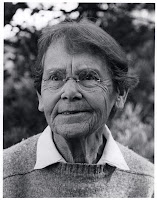The Dark Lady of DNA (1920-1958)
Rosalind Franklin's work in the structure of DNA has made a great contribution the the world of Genetics. Her expertise in X-ray diffraction helped her extract DNA fibers to study under humid conditions. This allowed her to discover the crucial key to the structure of DNA. However, she was not recognized for her accomplishments because of her hostile relationship with her assistant, Maurice Wilkins. Without permission, Wilkins presented her discovery (photograph 51) to Watson and Crick who was also working on the DNA structure at the time. This picture helped Watson and Crick deduce the helical structure of DNA in 1953. In 1962, Watson, Crick and Wilkins were rewarded The Nobel Prize for their discovery of the structure of DNA. Franklin died in 1958 at the age of 37.She was not recognized for her contributions or was she rewarded with The Nobel Prize because she had already passed away. It was unclear whether she would have been considered for the prize even if she was alive. It wasn't until twenty-five years later that Franklin's name was mentioned in Watson's journal, The Double Helix. Nevertheless, her contributions in the genetic world are well recognized today.
Erwin Chargaff (1905-2002)
Erwin Chargaff was a biochemist who proposed two main rules known as Chargaff's Rule. His first rule showed that in natural DNA the ratio of adenine and thymine were equal and guanine and cytosine were equal. In human DNA, the four bases are present in these percentages: A=30.9% and T=29.4%; G=19.9% and C=19.8%.This hinted the complementary base pairing of DNA.In 1952, Chargaff shared his idea with Crick and Watson which helped them develop the helical structure of DNA.His second rule stated that composition of DNA varies between species, specifically in the relative amounts of A, G, T, and C bases.Similar to Franklin, Erwin Chargaff was also not recognized or given The Nobel Prize for his contribution towards the structure of DNA.
Gregor Mendel (1822-1884)
Gregor Mendel, often crowned as the "Father of Genetics", derived the basic laws of heredity. His short monograph,Experiments with Plant Hybrids has become one of the most influential publications in the history of science. During his time, Mendel cross-bred pea plants in which he discovered his key insights. From his findings, he came up with the law of segregation (dominant and recessive genes) and the law of independent assortment (organism's individual traits are passed on independently of one another). Mendel's discoveries were not accepted during his time because they were far too advance. It wasn't until the 1900s when three botanists found his experimental data, that he became known.
Watson (1928) and Crick (1916-2004)
While working at Cambridge University, James D. Watson and Francis Crick proposed the DNA helical structure in 1953. They discovered that DNA was in the shape of a helix, about 2nm in diameter and had a complete helical turn every 3.4 nm. Their proposal was later published into an article called, Molecular Structure of Nucleic Acids: A Structure for Deoxyribose Nucleic. Both Watson and Crick along with Wilkins were awarded with the Nobel Prize in Physiology or Medicine in the year 1962 for their discovery.
Barbara McClintock (1902-1922)
Barbara McClintock made a significant contribution to the world of Genetics. She was interested in chromosome breakage as she observed the behaviors of chromosomes that lacked telomeres. In 1948, she had published a paper sharing her findings of the mutable loci. She discovered that the chromosome-breaking locus did "something" unknown. It moved from one chromosomal location to another. She called this transposition. McClintock discovered that transposition in genes are responsible for turning physical characteristics on or off. She developed theories to explain the repression or expression of genetic information from one generation of maize plants to the next. In 1983, she was rewarded with the Nobel prize.





No comments:
Post a Comment